
A recent mission by the Solar Orbiter, a collaborative effort between the European Space Agency (ESA) and NASA, has provided the first detailed look at the southern region of the sun. This remarkable achievement comes as our host star, located approximately 93 million miles away, is experiencing peak chaos in its solar cycle. Just like Earth’s storm seasons, the sun goes through a weather pattern that recurs approximately every 11 years, characterized by periods of heightened activity such as flares and sunspots.
During the solar cycle, activity rises before it eventually declines. At the climax of this cycle, the sun is marked by intense eruptions and turbulence. The Solar Orbiter captured these phenomena in March, providing imagery that no other spacecraft has managed to achieve at such close range. While prior missions focused on the sun's equator, the Solar Orbiter tilted its perspective to reveal the unexplored southern region.
The observations made by the Solar Orbiter were not entirely surprising, yet they continue to present mysteries. One of the most intriguing findings was that the sun's magnetic poles had flipped. Unlike a typical magnet that has distinct north and south poles, during this solar maximum phase, both poles are positioned at the sun's bottom. This phenomenon is temporary and leads to a single polarity dominating before the entire magnetic field undergoes a reconfiguration.
Sami Solanki, leader of one of the instrument teams at the Max Planck Institute for Solar System Research, emphasized the significance of the Solar Orbiter's timing and location. The spacecraft was specifically designed to observe these processes from a unique vantage point, enabling scientists to better understand the sun's complex behavior.
Launched in 2020, the Solar Orbiter utilized a gravity assist from Venus in February to adjust its trajectory, allowing it to view the sun from a new angle. This adjustment enabled its cameras to capture the southern region of the sun effectively. Previous missions, such as the now-retired Ulysses spacecraft, did fly over the sun's poles but lacked imaging capabilities.
The Solar Orbiter is equipped with an array of sophisticated instruments, each serving a distinct purpose. One instrument captures images in optical light, while another focuses on ultraviolet light. Additional instruments are designed to map the sun's surface magnetic field and observe light emitted from various temperatures of charged gas above the solar surface.
Although the fundamental mechanism of the solar cycle remains elusive, scientists believe that the key to understanding it lies at the sun's poles. One of the Solar Orbiter's primary objectives is to unravel the complexities of this cycle. The findings from this mission are not just of scientific interest; they may also enhance our ability to predict space weather events that can disrupt power grids, satellites, and navigation systems.
In the images taken in March, the Solar Orbiter observed the sun from an angle of 17 degrees below the solar equator. Over the next few years, the spacecraft will continue to tilt, with plans to reach a steeper angle of 23 degrees by December 2026, and potentially 33 degrees by 2029, allowing for a comprehensive mapping of both poles.
As the Solar Orbiter continues its mission, its contributions will undoubtedly deepen our understanding of the sun and its influence on our solar system.